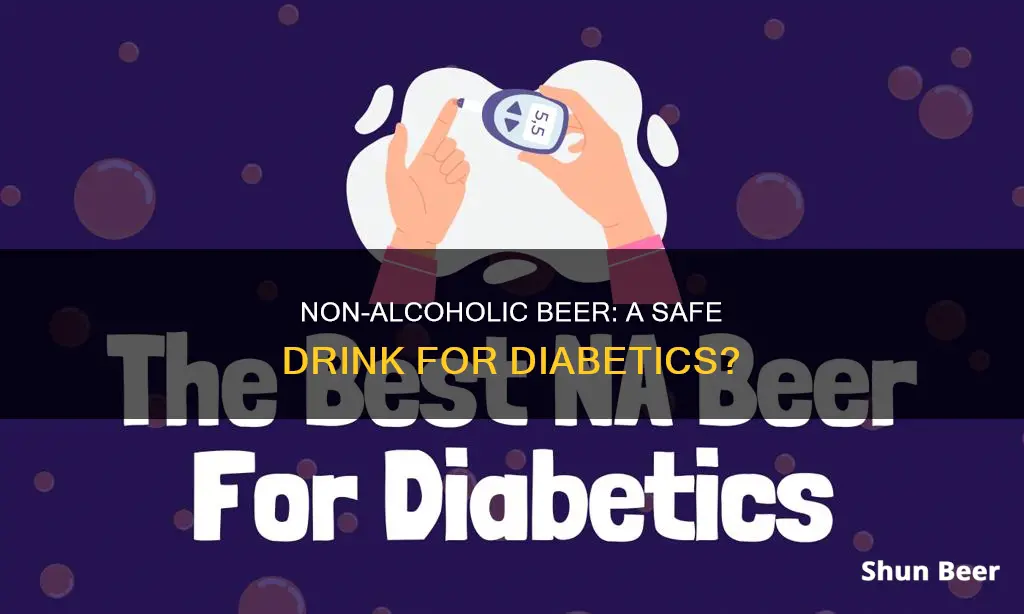
People with diabetes do not need to cut alcohol out of their diet, but there are some important safety considerations. Alcohol can affect blood sugar levels and insulin sensitivity, and drinking alcohol can have short-term and long-term consequences. Alcohol competes with the liver's ability to make glucose when blood sugar is low, which can lead to dangerously low blood sugar for up to 24 hours after drinking. To prevent hypoglycemia, it is recommended not to drink on an empty stomach, to have food while drinking, and to keep checking your blood sugar. Alcohol consumption recommendations are the same for people with diabetes as for the general population: no more than one drink a day for women and up to two drinks a day for men.
| Characteristics | Values |
|---|---|
| Alcohol consumption recommendations for diabetics | No more than one drink a day for women and up to two drinks a day for men |
| Binge drinking | Drinking more than four drinks (for women) or five drinks (for men) within two hours, is strongly discouraged |
| One serving of beer | 12 ounces |
| Light beers | Lowest in carbs, calories, and alcohol |
| Alcohol-free beer | Good choice for diabetics |
| Hypoglycemia prevention | Don't drink on an empty stomach, check your blood sugar often while drinking and up to 24 hours after you stop drinking |
What You'll Learn

Non-alcoholic beer calories are almost entirely from carbs
Non-alcoholic beer is a popular option for those looking to reduce their alcohol intake without giving up the taste of beer. While it contains little to no alcohol, non-alcoholic beer still contains calories, which can be surprising to some. On average, non-alcoholic beer has around 22.6 calories per 100ml, which is significantly lower than alcoholic craft beer, which has between 47.8 and 98.59 calories per 100ml.
The calories in non-alcoholic beer come mainly from carbohydrates, or carbs. In fact, non-alcoholic beers can contain more than twice as many carbohydrates as their alcoholic counterparts. This is because the process of removing alcohol from beer also removes some of its flavour, so sugar is often added to improve the taste. As a result, non-alcoholic beers can be higher in sugar and carbohydrates than standard beers, making them unsuitable for those following a low-carb or low-sugar diet.
For example, a 330ml bottle of Carlsberg (3.8% ABV) contains 122 calories, while the same-sized bottle of Carlsberg "0.0" (0% ABV) contains 73 calories. Similarly, a 330ml bottle of Peroni Libera Alcohol Free contains around 10g of sugar, which is a significant amount considering the NHS recommends that adults consume no more than 30g of sugar per day.
While non-alcoholic beer may have fewer calories than alcoholic beer, it's important to note that these calories are mostly from carbs and sugar, which can impact your health if consumed in excess. Therefore, while non-alcoholic beer can be a good option for those looking to reduce their alcohol intake, it may not be the best choice for those trying to cut down on calories or stick to a low-carb or low-sugar diet.
Beer and Acetaminophen: A Safe Mix?
You may want to see also

Diabetics can drink alcohol, but it may affect blood sugar levels
To reduce the risk of hypoglycemia, it is important for diabetics to follow certain guidelines when consuming alcohol. Firstly, drinking on an empty stomach should be avoided. Eating food, especially carbohydrates, before and during alcohol consumption can help prevent hypoglycemia. It is also crucial to monitor blood sugar levels regularly before, during, and after drinking, and to be vigilant for up to 24 hours afterward.
The type of alcohol consumed also makes a difference. Beer, for example, is typically high in carbohydrates, with hoppy craft beers like IPAs and stouts containing 15 grams or more per serving. "Light" beers are a better option, usually containing 5 grams or fewer carbohydrates per serving. When it comes to wine, red wine is generally recommended over white wine due to its higher antioxidant content and potential health benefits for diabetics.
Distilled spirits or hard liquors, such as gin, rum, vodka, and whiskey, contain zero grams of carbohydrates per serving. However, they can still lead to hypoglycemia, especially if consumed on an empty stomach. Mixing liquor with sugary juices or soda should be avoided, as it can cause a spike and subsequent dip in blood sugar levels.
Moderate alcohol consumption, defined as up to one drink per day for women and up to two drinks per day for men, is generally considered safe for diabetics. However, it is important to be mindful of serving sizes, as they can vary. For example, a large 24-ounce can of beer, commonly found at sports stadiums, counts as two drinks.
While diabetics can drink alcohol, it is crucial to follow the recommended guidelines and monitor blood sugar levels closely to avoid potential health complications.
Gluten Insensitivity and Beer: Is It Safe to Drink?
You may want to see also

Alcohol competes with the liver's ability to make glucose
Alcohol can affect the liver's ability to make glucose in several ways. Firstly, the liver is responsible for breaking down alcohol, and if an individual drinks more than it can process, the liver can become damaged. This damage can lead to alcohol-associated liver disease, which includes steatotic (fatty) liver, acute hepatitis, and cirrhosis. As the liver plays a crucial role in glucose regulation, any disruption to its function can impact glucose levels in the body.
Secondly, alcohol interferes with the liver's ability to regulate blood sugar levels. Normally, the liver stores glycogen, a form of carbohydrate, and releases it to maintain blood sugar levels if they drop too much between meals. However, when alcohol is present, the liver's attention is diverted to metabolizing it, taking away resources from its blood sugar-regulating function. This can lead to a drop in blood sugar levels, known as hypoglycemia, which can be dangerous for individuals with diabetes.
Additionally, alcohol metabolism in the liver involves the breakdown of alcohol into acetaldehyde, a toxic compound, and further into acetate. This process can affect the liver's redox state, specifically the NAD+/NADH ratio, which can have downstream effects on other metabolic pathways that require NAD+ or are inhibited by NADH. These pathways include the citric acid cycle, pyruvate dehydrogenase, and fatty acid oxidation.
Furthermore, alcohol competes with normal nutrients for metabolism by the liver. Alcohol is preferentially oxidized over other nutrients, which means that the metabolism of carbohydrates, proteins, and fats is reduced. This can impact the body's ability to utilize these nutrients effectively, potentially affecting overall energy levels and metabolic function.
Finally, alcohol can increase the risk of developing diabetes or worsen existing diabetes. Heavy drinking can lead to weight gain, as alcohol is often high in calories, and it can also make weight control more difficult. Obesity is a risk factor for type 2 diabetes, and drinking alcohol can contribute to this. Therefore, alcohol can indirectly affect the liver's ability to regulate glucose by increasing the risk of diabetes and disrupting overall metabolic function.
Root Beer Guzzling: How Much A&W is Too Much?
You may want to see also

Drinking in moderation is recommended for diabetics
For those with diabetes, drinking in moderation is safer than abstaining from alcohol completely. However, there are some important safety considerations to keep in mind. Firstly, alcohol can interfere with diabetes medications, including insulin, sulfonylureas, and metglitinides, leading to a dangerous drop in blood sugar levels. This effect can last up to 24 hours after drinking, so it is crucial to monitor blood sugar levels closely during this period. To prevent hypoglycemia, it is recommended to drink moderately and ensure you have food before and while consuming alcohol. Keep checking your blood sugar levels and stay hydrated by drinking water alongside alcoholic drinks.
The recommended alcohol consumption guidelines for people with diabetes are the same as for the general population: no more than one drink per day for women and up to two drinks per day for men. "Binge drinking" is strongly discouraged for health and safety reasons. When it comes to beer, one drink is typically 12 ounces, or one can or bottle. However, it's important to note that some containers might be larger, such as the 24-ounce cans commonly found at sports stadiums, which count as two drinks.
If you have diabetes and want to include alcohol in your diet, it's best to opt for low-carb and low-alcohol beverages. "Light" beers, for example, have fewer carbs, usually five grams or less per serving, and a lower alcohol content. In contrast, hoppy craft beers like IPAs and stouts tend to have higher carbs, often 15 grams or more per serving, as well as higher calories and alcohol content. Therefore, if you plan to have more than one beer, sticking to light beers is a better option.
Moderate alcohol consumption, defined as up to one to two drinks per day, is generally safe for individuals with diabetes. However, it is crucial to be mindful of the potential risks and take the necessary precautions, such as drinking slowly, staying hydrated, and consuming carbohydrates before and during drinking. Additionally, always wear a medical ID that states your diabetes condition, and inform your companions about the risk of hypoglycemia while drinking.
Apple Cider Vinegar and Beer: A Healthy Mix?
You may want to see also

Diabetics should not drink on an empty stomach
For people with diabetes, drinking alcohol may be safe as long as they choose the right types of drinks and consider alcohol's effects on their blood sugar levels. However, it is important to note that the safest option is to avoid alcohol completely. If you have diabetes and insist on drinking, it is crucial to follow certain guidelines to ensure your safety.
One crucial guideline is to avoid drinking on an empty stomach. Drinking alcohol on an empty stomach can lead to hypoglycemia, or dangerously low blood sugar levels. This is because alcohol competes with the liver's ability to produce glucose, especially when blood sugar is already low. If you are on insulin or other anti-hyperglycemic medications, drinking on an empty stomach can further increase the risk of hypoglycemia, which may persist for up to 24 hours after you stop drinking. Additionally, alcohol can impair your judgment, making it difficult to recognize the signs of low blood sugar.
To prevent hypoglycemia, it is recommended to consume food, especially carbohydrates, before and while drinking. This helps ensure that your blood sugar levels do not drop too low. It is also important to monitor your blood sugar levels regularly before, during, and after drinking, as well as up to 24 hours afterward. By checking your blood sugar levels, you can identify any potential issues and take appropriate corrective actions.
Furthermore, drinking in moderation is essential. The general alcohol consumption recommendations for people with diabetes are the same as for the general population: no more than one drink per day for women and up to two drinks per day for men. Binge drinking is strongly discouraged for health and safety reasons. When drinking, it is advisable to pace yourself and not exceed one drink per hour, with a maximum of three or four drinks for the day. Staying hydrated by drinking plenty of water is also important.
In summary, while people with diabetes do not need to completely abstain from alcohol, it is crucial to follow certain guidelines to ensure safe consumption. Drinking on an empty stomach should be avoided, as it can lead to hypoglycemia and impair your judgment. Instead, consume food, especially carbohydrates, before and during drinking, and regularly monitor your blood sugar levels. Additionally, drinking in moderation and staying hydrated are important components of safe alcohol consumption for people with diabetes.
Beer and Yeast Infections: Is It Safe to Drink?
You may want to see also
Frequently asked questions
Non-alcoholic beer contains almost all carbohydrates, which can be harmful to diabetics. However, moderate alcohol consumption (no more than one to two drinks per day) is considered safe for most diabetics.
Alcohol can interfere with diabetes medications and lead to dangerously low blood sugar levels. It can also impair judgment, making it difficult to recognise low blood sugar.
Diabetics should not drink on an empty stomach and should monitor their blood sugar levels regularly before, during, and after drinking. It is also important to stay hydrated and pace yourself when drinking.







